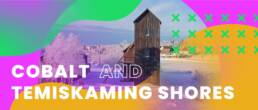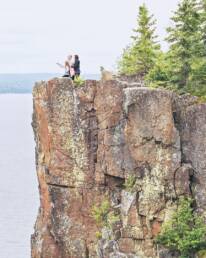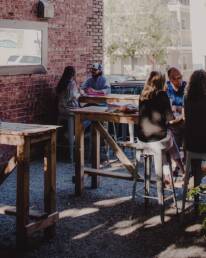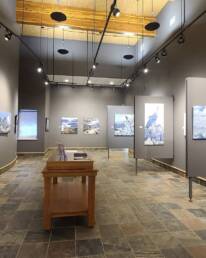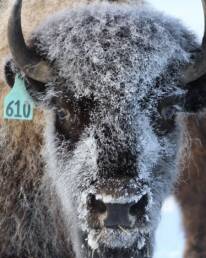Cobalt and Temiskaming Shores
Rocky Canadian shield, vast lakes, majestic forests — welcome to Ontario’s north. Indigenous peoples have inhabited these lands for centuries and Lake Temiskaming, at the headwaters of the Ottawa River, makes it an historic region for transportation and trade. Then there’s the extraordinary history of Cobalt’s silver rush in 1903, resulting in headlines around the world. No wonder the region provided inspiration for artists like the Group of Seven.
February 28, 2022 | Banner photo by Sue Nielsen
Day One
COBALT SILVER HERITAGE TRAIL — 10:00 AM
THE SILVER BOOM THAT SURPRISED THE WORLD
The stampede for glittering silver turned Cobalt into the fourth-largest silver producer in history, with Willet G. Miller, Ontario’s first provincial geologist, noting there were “pieces of native silver as big as stove lids and cannon balls.” In truth, for two thousand years before white man’s ‘discovery’ of silver, Indigenous people had been trading metals from the area — ceremonial panpipes and jewellery made from Cobalt silver has turned up in burial mounds and archeological digs across North America. This did not deter white prospectors and claim jumpers though. They swelled the town’s population, and the frenetic growth included everything from saloons to an opera house. The speed at which Cobalt was born is evidenced today in the curving streets and wood-framed houses perched precipitously on hills. It’s a bit of a time machine, with the old mining buildings best explored via the self-guided Cobalt Silver Heritage Trail. For a look through an arts lens, visit Lake Temiskaming Tours.
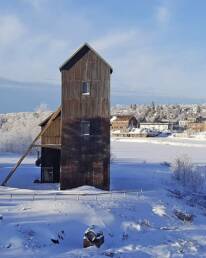
THE COBALT MINING MUSEUM — 1:00 PM
A TREASURE TROVE OF SILVER STORIES
Take a lunch break at the Silver Café, an unpretentious spot with good diner fare. Or nab fresh baked goods at the wittily-named Fresh AF Market & Eatery. It’s a farm-to-market grocers, hence the name: Fresh (A)s (F)arm Market. Then head to the Cobalt Mining Museum, a literal treasure trove with the world’s largest display of native silver ore, plus a deep-dive collection of silver rush artifacts. At its mining peak Cobalt had over 100 mines, and it’s credited with creating the Toronto Standard Stock and Mining Exchange in 1908. As the joke of the day went, Toronto was the place you changed trains to get to Cobalt! No wonder Cobalt’s been called Ontario’s Most Historic Town and is a Parks Canada National Historic Site.
WHITE MOUNTAIN TO THUNDER / DEVIL‘S ROCK — 3:00 PM
A LITTLE BROWSING, A LITTLE HIKING
White Mountain Books provides excellent browsing as well as the opportunity to learn more about local history. The bookstore is even housed in an historic site, the Coniagas Shaft House #4 at Silver Street and Prospect Avenue. Check out Poor Boy Soles Bespoke Shoe Co. for made-to-measure footwear and leather goods using traditional techniques. Then visit Laura’s Art Shoppe for locally-made sculpture, pottery and glass creations, as well as cards and prints reflecting Temiskaming’s beauty. From shopping to hiking — a fifteen-minute drive east takes you to the magnificent cliff originally known as Manidoo-Wabikong, today as Thunder / Devil’s Rock. The 40-minute hike (two to four kilometres, depending on the trail) ends with superb views of Lake Temiskaming. Thunder / Devil’s Rock has literary history too, featured on the cover of the Hardy Boys mystery, The House on the Cliff, ghost written by local (and highly successful) author Leslie McFarlane.
PUB OR TAVERNE TIME — 6:00 PM
DELICIOUS DINING, CRAFT BEER AND LIVE MUSIC
Just north of Cobalt is Temiskaming Shores, the amalgamation of the towns of New Liskeard and Haileybury and the township of Dymond. (You may want to motel it in either Haileybury or New Liskeard — a ten minute drive apart. The latter’s Waterfront Inn has terrific lake views.) For a pub stop in Cobalt the place to go is Miner’s Tavern, boasting live local music. Or check out the Classic Theatre, the only remaining theatre from the silver boom, with shows ranging from theatre and music to comedy. Heading straight to Haileybury? Consider dining at L’Autochtone Americaine Taverne, with its “contemporary take on North American classics as seen through an Indigenous lens.” Makes sense, given the area is home to three cultures: Indigenous, Quebecois and English. Coffee hounds note: L’Autochtone Americaine also runs Busters Mini-Mart, a hybrid café-specialty food store. As for craft beer fans, your destination is Haileybury’s The Whiskey Jack Beer Company.
Day Two
WANDER HAILEYBURY — 10:00 AM
THE HOME OF MILLIONAIRE’S ROW
Haileybury was founded in 1889 by Charles C. Farr, an employee of Hudson Bay Company. As a lakeside neighbour to Cobalt, many mining bigwigs made it their home, evidenced by beautiful houses from that era that still exist on Lakeshore Road, once known as Millionaire’s Row. Walking in downtown Haileybury and out to the marina is a great way to see the town and its lovely sand beach, complete with waterslide.
HAILEYBURY HERITAGE MUSEUM / TEMISKAMING ART GALLERY — 11:00 AM
HISTORY AND HERITAGE IN HAILEYBURY
Drop into the Haileybury Heritage Museum to explore the town’s history, in particular the 1922 fire (one of the ten worst natural disasters in Canadian history). It’s an essential stop for Northern Ontario history buffs and kids alike. The latter will beeline to the fire truck, streetcar and tugboat on display. The former will be intrigued to know that, after the fire, Toronto sent a fleet of streetcars… for relief housing. Next, head to the Temiskaming Art Gallery, a showcase for both local artists as well other artists from Ontario’s north. The gallery is also home to Open Studio Libre, a free-access art studio
NEW LISKEARD — 1:00 PM
A LAKE LUNCH STOP
New Liskeard, the biggest of the three towns making up Temiskaming Shores, is on the northwest tip of Lake Temiskaming, making it a perfect place to savour the vast lake’s beauty. Savour lunch too, with options including Tap That Bar & Kitchen’s “barrel aged cocktails to craft burgers and comfort food” or Ali’s Grill & Bar’s “casual fine dining.” Café and book/game lovers check out Chat Noir Books with its vast collection of books and games, plus specialty coffees. The Riverside Farmers’ Market is a seasonal stop on Saturdays for farm-fresh produce, and local crafts and artwork. Also on the waterfront, take time for reflection at the moving monument to Shannen Koostachin, who led a campaign to have a new school built in her Indigenous community — the largest youth-led rights movement in Canadian history.
LITTLE CLAYBELT MUSEUM TO BISON DU NORD — 3:00 PM
COWS, PIONEERS, CHEESE… AND BISON!
North of New Liskeard the land transitions from rugged shield to the flatlands of the clay belt, a surprise to many first-time northern visitors. The giant Ms. Claybelt, a 12-foot tall cow, stands proudly beside The Little Claybelt Homesteaders Museum as a marker of the region’s agricultural prowess. The museum itself looks at early pioneer life from the 1880s to the 1950s. Continue north on highway eleven stopping at farmer-owned, award-winning Thornloe Cheese (20 minutes), and Bison du Nord (30 minutes). Bison du Nord is the largest bison farm in Eastern Canada, with educational tours letting you get up close to the shaggy beasts.
EVENING IN NEW LISKEARD — 7:00 PM
WINING, DINING, AND WALKING
A popular spot for dinner is 28 On The Lake for high-end pub food and a great view of Lake Temiskaming. Or check out Zante’s Bar & Grill, with farm-to-table cuisine. Take a post-dinner stroll along the lovely waterfront boardwalk trail before enjoying live music at either of the above (Zante’s is also home to trivia nights). Note to Francophiles: check out Le Centre culturel ARTEM for everything from Francophone bingo to singing barbers.
YOUR TRIP AT A GLANCE
SEE
COBALT SILVER HERITAGE TRAIL
LAKE TEMISKAMING TOURS
COBALT MINING MUSEUM
THE CLASSIC THEATRE COBALT
MANIDOO-WABIKONG, KNOWN TODAY AS THUNDER/DEVIL’S ROCK
HAILEYBURY HERITAGE MUSEUM
TEMISKAMING ART GALLERY
MS. CLAYBELT
THE LITTLE CLAYBELT HOMESTEADERS MUSEUM
BISON DU NORD
LE CENTRE CULTUREL ARTEM
MONUMENT TO SHANNEN KOOSTACHIN
NEED A MAP?
This guide represents a weekend-long experience, highlighting one of the many wonderful destinations in the area. To suggest a destination for a future guide, please contact us.
All editorial decisions were made at the sole discretion of Ontario Culture Days staff. This guide was written by Li Robbins.

